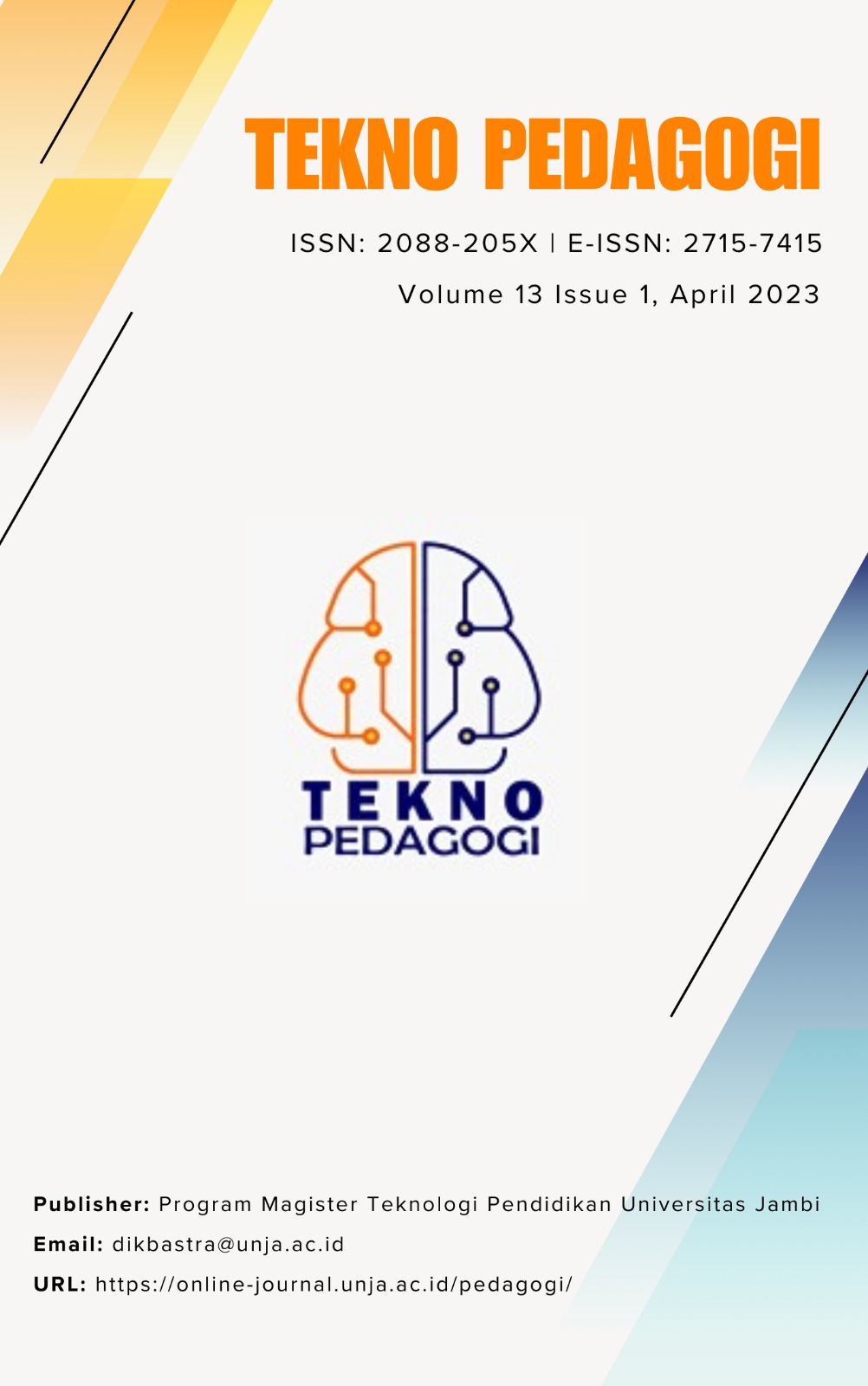Tapping Into Creativity: Crafting Engaging Math Lessons for Middle Schoolers with Macromedia Flash
DOI:
https://doi.org/10.22437/teknopedagogi.v13i1.36396Keywords:
Instructional Media, Realistic Mathematics Education, Curved Side Space BuildingsAbstract
The aim of the research is to design media based on Realistic Mathematics Education (RME) spatial material; producing RME media with Macromedia Flash for class IX educators and students building materials; knowing the responses of educators and students after using the media; find out the results of learning about curved sided space figures. RME media development refers to the model of William W. Lee and Diana L. Owens by going through four stages out of five existing stages, namely: analysis; product design; development; implementation; and evaluation. In this research, the evaluation stage was not carried out. The results of expert validation obtained an average score of 88.8%, individual trials an average of 81.33%, small group trials an average of 80.89%, educators' responses to the media an average of 87.33%, and responses students average 83.73%. The use of RME media in learning has an impact on learning outcomes, where the average learning outcome for the experimental class is 81.65 while the average learning outcome for the control class is 78.39. The differences in learning outcomes show that RME media is effective when used in classroom learning.Explore a dynamic approach to math education as students delve into real-world scenarios, navigating building spaces with interactive Macromedia Flash tools. This innovative learning media sparks curiosity and deepens understanding, fostering a practical grasp of mathematics concepts for middle school learners.
Downloads
References
Ananda, A. P., & Hudaidah, H. (2021). Perkembangan Kurikulum Pendidikan Di Indonesia Dari Masa Ke Masa. SINDANG: Jurnal Pendidikan Sejarah Dan Kajian Sejarah, 3(2), 102–108. https://doi.org/10.31540/sindang.v3i2.1192
Ardina, F. N., Fajriyah, K., & Budiman, M. A. (2019). Keefektifan Model Realistic Mathematic Education Berbantu Media Manipulatif Terhadap Hasil Belajar Matematika pada Materi Operasi Pecahan. Jurnal Pedagogi Dan Pembelajaran, 2(2), 151. https://doi.org/10.23887/jp2.v2i2.17902
Ariyanti, I. (2022). Pengembangan Multimedia Pembelajaran Untuk Peserta Didik Di Tingkat Taman Kanak-Kanak. Educational Technology Journal, 2(1), 34–44. https://doi.org/10.26740/etj.v2n1.p34-44
Diantoro, F., Purwati, E., & Lisdiawati, E. (2021). Upaya Pencapaian Tujuan Pendidikan Islam Dalam Pendidikan Nasional Dimasa Pandemi Covid-19. MA’ALIM: Jurnal Pendidikan Islam, 2(01), 22–33. https://doi.org/10.21154/maalim.v2i01.3035
Febriyanti, F., Bagaskorowati, R., & Makmuri, M. (2019). The Effect of The Realistic Mathematics Education (RME) Approach and The Initial Ability of Students on The Ability of Student Mathematical Connection. International Journal for Educational and Vocational Studies, 1(3), 153–156. https://doi.org/10.29103/ijevs.v1i3.2117
Juliawan, R., Haris, A., Salahuddin, M., & Sari, I. P. (2022). Meningkatkan Kemampuan Siswa dalam Memahami Konsep Matematika Menggunakan Pendekatan Realistic Matematika Education (RME). Jurnal Pendidikan Dan Konseling (JPDK), 4, 2605–2611.
Khotimah, K., & Mahmudah, A. (2021). Math Learning With Realistic Mathematics Education Approach Based On Open-ended Problems. APPLICATION: Applied Science …, 1(1), 13–22. https://ejournal.unwaha.ac.id/index.php/application/article/view/1422%0Ahttps://ejournal.unwaha.ac.id/index.php/application/article/download/1422/657
Mahendra, M. R., Supriansyah, & Zulherman. (2021). Development of Macromedia Flash-Based Mathematics Learning for Elementary School Students. Journal of Physics: Conference Series, 1783(1). https://doi.org/10.1088/1742-6596/1783/1/012006
Mariana, N., Sholihah, S. A., Riski, R., Rahmawati, I., Wiryanto, W., Indrawati, D., & Budiyono, B. (2021). In-service teachers’ perception on implementing realistic mathematics education approach in their best practices. Journal of Physics: Conference Series, 1987(1). https://doi.org/10.1088/1742-6596/1987/1/012022
Mila, N., Nuralamsyah, Alisyahbana, A. N. Q. A., Arisah, N., & Hasan, M. (2021). Efektivitas Pemanfaatan Canva Sebagai Media Pembelajaran Daring. PROSIDING SEMINAR NASIONAL PENELITIAN DAN PENGABDIAN 2021, “Penelitian Dan Pengabdian Inovatif Pada Masa Pandemi Covid-19", 181–188.
Nurhamidah, S. D., Sujana, A., & Karlina, D. A. (2022). Pengembangan Media Berbasis Android Pada Materi Sistem Tata Surya Untuk Meningkatkan Penguasaan Konsep Siswa. Jurnal Cakrawala Pendas, 8(4), 1318–1329. http://dx.doi.org/10.31949/jcp.v8i2.3190
Palinussa, A. L., Molle, J. S., & Gaspersz, M. (2021). Realistic mathematics education: Mathematical reasoning and communication skills in rural contexts. International Journal of Evaluation and Research in Education, 10(2), 522–534. https://doi.org/10.11591/ijere.v10i2.20640
Putri, S. K., Hasratuddin, H., & Syahputra, E. (2019). Development of Learning Devices Based on Realistic Mathematics Education to Improve Students’ Spatial Ability and Motivation. International Electronic Journal of Mathematics Education, 14(2), 243–252. https://doi.org/10.29333/iejme/5729
Rohid, N., Suryaman, & Rusmawati, R. D. (2019). Students’ Mathematical Communication Skills (MCS) in Solving Mathematics Problems: A Case in Indonesian Context. Anatolian Journal of Education, 4(2), 19–30. https://doi.org/10.29333/aje.2019.423a
Rusdi, Fauzan, A., Arnawa, I. M., & Lufri. (2020). Designing Mathematics Learning Models Based on Realistic Mathematics Education and Literacy. Journal of Physics: Conference Series, 1471(1). https://doi.org/10.1088/1742-6596/1471/1/012055
Silalahi, D. E., Siallagan, H., Munthe, B., Herman, & Sihombing, P. S. R. (2022). Investigating Students’ Motivation toward the Use of Zoom Meeting Application as English Learning Media during Covid-19 Pandemic. Journal of Curriculum and Teaching, 11(5), 41–48. https://doi.org/10.5430/JCT.V11N5P41
Ulandari, L., Amry, Z., & Saragih, S. (2019). Development of Learning Materials Based on Realistic Mathematics Education Approach to Improve Students’ Mathematical Problem Solving Ability and Self-Efficacy. International Electronic Journal of Mathematics Education, 14(2), 375–383. https://doi.org/10.29333/iejme/5721
Wardani, M. S., Nugroho, N. R. I., & Ulinuha, M. T. (2019). Penguatan Pendidikan Karakter dalam Proses Pembelajaran Bahasa Inggris. Buletin Literasi Budaya Sekolah, 1(1), 27–33. https://doi.org/10.23917/blbs.v1i1.9313
Yetri, O., Fauzan, A., Desyandri, D., Fitria, Y., & Fahrudin, F. (2019). Pengaruh Pendekatan Realistic Mathematics Education (RME) dan Self Efficacy terhadap Kemampuan Pemecahan Masalah Matematis Siswa di Sekolah Dasar. Jurnal Basicedu, 3(4), 2000–2008. https://doi.org/10.31004/basicedu.v3i4.249
Downloads
Published
How to Cite
Issue
Section
License
Copyright (c) 2023 Sukamdi, Aira Lepik, Viktor Denkovski

This work is licensed under a Creative Commons Attribution 4.0 International License.





